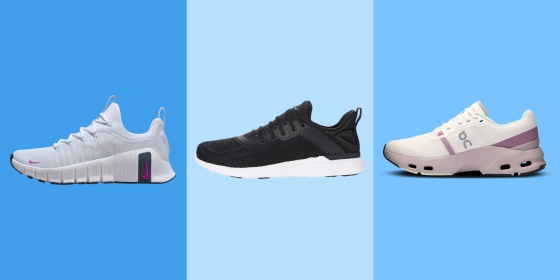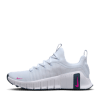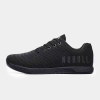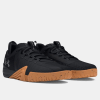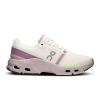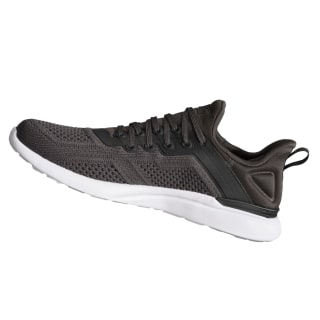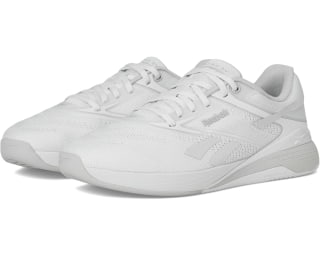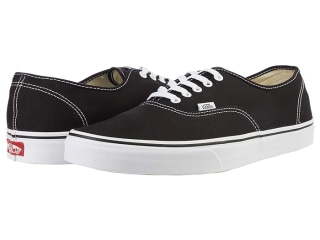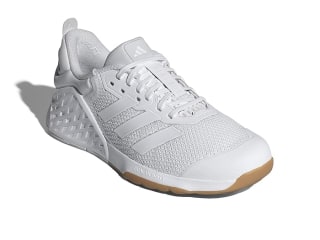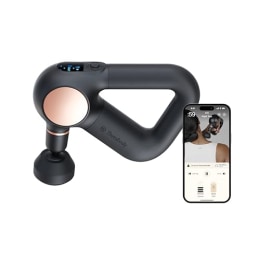Think twice before throwing on a pair of running sneakers for an aerobics class or weightlifting session. These types of workouts call for training shoes: lightly cushioned, flat, firm sneakers that prioritize stability and keep you grounded. “Think of them as your jack of all trades gym shoes,” says Dr. Alicia Canzanese, a podiatrist and certified athletic trainer. “They’re made for HIIT workouts, CrossFit, weight training and short running or jumping exercises.”
To help you find the right pair of training shoes, I talked to experts about what to look for while shopping. The NBC Select staff have also been testing training shoes for the past two years, so I rounded up our favorite options across support level, price and activity type.
SKIP AHEAD The best training shoes of 2025 | Why trust NBC Select?
Want more from NBC Select? Sign up for our newsletter, The Selection, and shop smarter.
How I picked the best training shoes
While shopping for training shoes (which are also often called workout and gym shoes), experts recommend thinking about the following factors.
- Activity: For stationary activities like weightlifting and using gym equipment (cable machines, for example), go with flatter, minimalistic options, says Canzanese. For activities that require short bursts of running or jumping, like HIIT, go with training shoes that have a bit more cushioning to support your feet and absorb impact.
- Stack height: Stack height is the amount of material between your foot and the ground. It generally equates to how much cushioning a shoe’s midsole has, meaning the portion of foam that connects the shoe’s outsole to its upper (the area that covers the entire foot). A taller stack height means more cushioning, while a shorter stack height means less, says Canzanese. Compared to running shoes, training shoes typically have a shorter stack height and less cushioning because they’re meant to be firm and stabilizing. Even the most cushioned training shoes you’d wear for HIIT workouts won’t be as soft or squishy as running shoes, says Canzanese.
- Offset: Offset, also called heel drop, is the difference between the height of the heel and toe of a shoe. Training shoes are known for having a low offset of somewhere between zero and eight millimeters, meaning they’re quite flat, says Canzanese. Flat soles give you a stable base, allow you to connect all points of your foot to the ground and evenly distribute your weight across it to aid your grip, says Olivia Amato, a Peloton Bike, Tread and Strength instructor.
- Outsole: Experts say rubber outsoles give you the best grip on gym floors. Paired with a firm heel, they also stabilize your feet, especially when you’re landing from a jump or doing lateral movements, says Amato.
- Toe box: Your training shoe’s toe box should be wide enough to comfortably spread out your toes and move them around, says Amato. This helps you maximize how much contact your foot makes with the ground, especially while doing exercises that require you to push off or put a lot of weight on the front part of the foot. When you try on training shoes, make sure your toes don’t feel like they’re being squeezed together — if they do, the toe box is too narrow, says Canzanese.
- Arch support: Wearing the wrong shoe for your arches can cause pain for the bottoms of your feet, commonly felt as an uncomfortable burning sensation, says Kollins Ezekh, a certified personal trainer, boxing coach and owner of Members Only Boxing and Fitness. While shopping for training shoes, you’ll often see them labeled as neutral, cushioning or stability shoes, which tend to be best for those with neutral, high and flat arches, respectively, says Canzanese. Check brands’ websites to see if this type of language is listed on product pages, and if so, whether the training shoes you’re interested in aligns with your arch type. (Learn how to determine your arch type in the FAQ section below.)
- Size: People often buy running sneakers half a size larger to account for swelling and foot expansion. Training shoes, however, should perfectly fit your feet. Your feet should not slide around in the shoes whatsoever, so be sure to buy the exact size your feet measure, says Ezekh. Ill-fitting shoes can cause foot pain, blisters and calluses, says Amato.
- Return policy: Taking a pair of training shoes for a test drive is the best way to determine whether they fit well and work for the types of exercise you do, experts say. While shopping online, check retailers’ return policies to see how long you have to decide whether you’re keeping them.
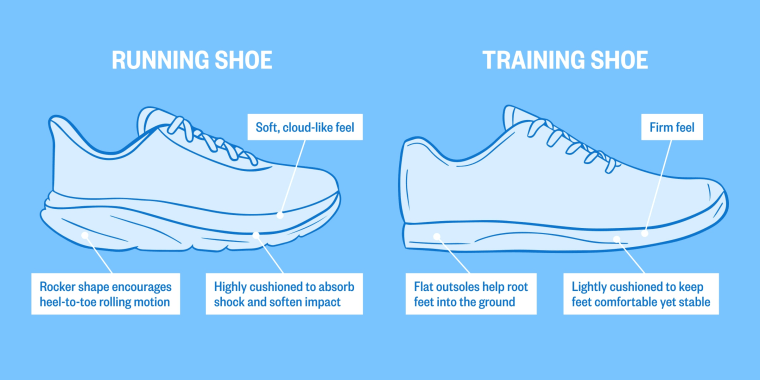
The best training shoes of 2026
To recommend the best training shoes, I compiled a list of experts’ favorite models and those the NBC Select staff have tested. Not all brands disclose their training shoes’ stack heights, offsets and arch support types — if they do, that information is also below. Every training shoe on this list is available in half and whole sizes, and they all come in various colors.
Best overall: Nike Free Metcon 6
- Secure feet in place
- Flexible mid- and outsole
- Reinforced heel
- Best worn with thin socks
Nike’s Metcons are one of the most popular training shoes for working out, says Ezekh, who wears them while doing deadlifts and squats. NBC Select SEO editor Nikki Brown also loves them. “They’re as comfortable as they are stylish, and extremely supportive for my very flat feet,” she says. “I like wearing them while using my vertical climber at home — they’re not too bouncy and keep my feet sturdy while I’m pushing down on the steps.”
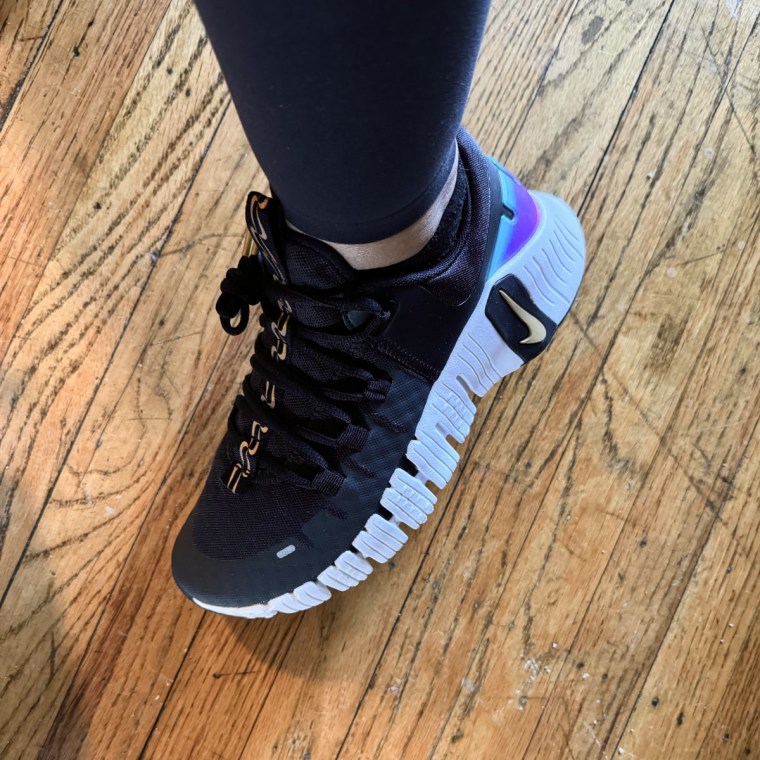
The Metcons have a flexible midsole and outsole to support your feet’s natural movements whether you’re jumping or lifting weights. Their cushioning helps soften your impact and keep feet comfortable, and their heel is reinforced with foam to create a stable base. The shoes are also designed with grippy outsoles and breathable, lightweight, stretchy mesh uppers, as well as cables that connect the lacing and sole to secure feet in place.
Men’s sizes: 6 to 15 | Women’s sizes: 7.5 to 16.5
Best for HIIT: APL TechLoom Tracer
- Maximum stability
- Slip on or lace up
- Light cushioning
- Snug fit at first
APL’s TechLoom Tracer is one of my favorite training shoes, and it’s designed with a non-stretch material to keep your feet centered on the footbed and offer lateral stability, according to the brand. I wear these shoes while doing HIIT workouts because they’re equally supportive during strength and cardio bursts. I find them especially beneficial for sculpt classes where I quickly switch between Pilates exercises with dumbbells and dance sections.
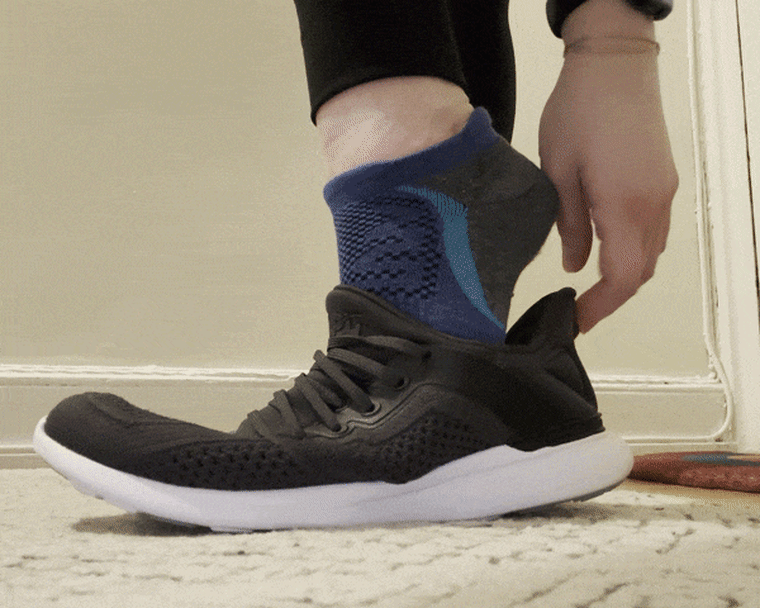
The TechLoom Tracers have an 8 millimeter offset and light cushioning that keeps my feet padded, but it’s not too thick, so I’m always close to the ground while training. The shoe’s collar and tongue are soft against my skin, plus its sculpted heel and rubber traction pads help me keep my balance. I also love that I can tuck the shoe’s laces in so they’re slip-ons, or tie them in a bow.
It’s important to note that these shoes have a snug fit at first, but the more you wear them, the more they loosen up. I had a hard time getting them on and off my feet for a week or two, but now I easily slip them on.
Men’s sizes: 7 to 15 | Women’s sizes: 5 to 11
Best for cross training: Reebok Nano X5
- Dual-density midsole
- Flexible outsole
- Breathable upper
- Firm feel
Reebok first launched its Nano training shoes in 2011, and the X5s are the newest iteration. Compared to the X3s and X4s, which I’ve also tested, these are hands-down the most comfortable and versatile. They’re designed for cross training, meaning incorporating different types of exercise into your workout regime to target all the muscle groups in your body. I mainly wear the Nano X5s while lifting weights, riding a stationary bike and using the elliptical machine. I can comfortably use them for over an hour and feel stable while doing different movements.
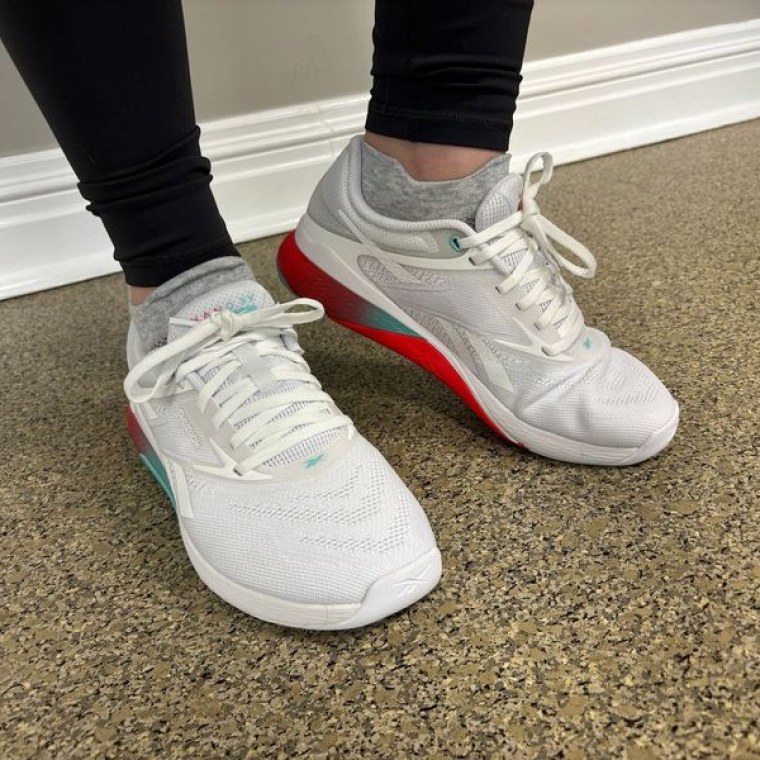
The X5s have a dual-density midsole with a firm, stabilizing foam in the heel and a softer, more responsive foam in the forefoot to support you during short stints of running or jumping. The shoe’s plush collar helps keep your feet in place, and its outsole is decoupled, meaning it’s separated into two parts to make it more flexible. It also has a grippy rubber outsole and breathable polyester upper.
Men’s sizes: 7 to 14 | Women’s sizes: 8.5 to 15.5
Best basic training shoe: No Bull Outwork
- Wider toe box
- Water-repellent
- Breathable tongue
- Snug fit
With a 4 millimeter offset, low cushioning, grippy rubber outsole and wide toe box, the NoBull Outwork meets all of experts’ specifications for an ideal training shoe. Their upper is made from the brand’s SuperFabric, a durable material treated with a water-repellent coating, and their tongue is perforated to keep your feet cool. The shoes have a snug fit, so some customers prefer ordering a half size up from what they normally wear, according to the brand.
Men’s sizes: 8 to 16 | Women’s sizes: 5 to 11
Best for heavy weights: Vans Authentic Shoe
- Very little cushioning
- Spacious toe box
- Durable, grippy rubber outsole
- Not best for aerobics
For stationary lifts like deadlifts with heavy weights, wear a training shoe that has the least amount of cushioning possible, says Canzanese. Cushioning can compress under a heavy load, which compromises your stability, form and technique. That said, Vans are a completely legitimate deadlifting shoe, as are basic Converse, says Canzanese. “They’re nice and spacious by the toe, and their outsole is completely rubber and durable, so it’s not going to compress under a heavy load. The bottoms are also really grippy so you’re not going to slip at all.” However, since Vans are so flat and designed with little cushioning, they’re not great for training that incorporates aerobics like running or jumping. You can buy these Vans in standard and wide sizes.
Men’s sizes: 3.5 to 17 | Women’s sizes: 5 to 18.5
Best for stationary activities:Under Armour UA Reign 6 Training Shoe
- Flat base
- Extra grippy outsole
- Highly stabilizing
- Firm feel
These training shoes have a 2 millimeter offset, making them one of the flattest pairs on this list, so they’re best for weightlifting and other stationary activities like using cable machines or similar gym equipment. The sneakers’ breathable, durable mesh upper keeps feet cool and they have a rubber outsole, plus additional rubber under the toe box to increase grip. There’s also a triangle base in the outsole that helps your feet maintain contact with the ground. The shoes are made with two heel stabilizers and dual-density foam in the midsole — there’s softer foam in the forefoot and firmer foam in the heel.
Men’s sizes: 7 to 15 | Women’s sizes: 5 to 12
Most breathable: Adidas Dropset 3 Strength Training Shoes
- Airflow window
- Wider fit
- Stabilizes heels
- Firm feel
These training shoes have an airflow window that you can see when you flip them over — the little cutout goes through the midsole and outsole and has mesh over it.
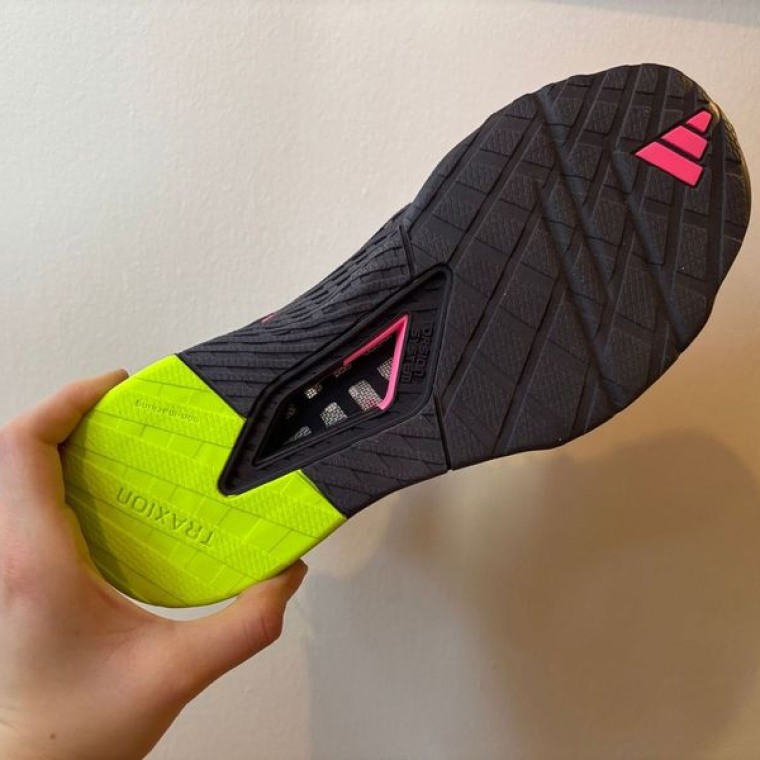
The airflow window greatly increases the shoes’ breathability, keeping my feet cooler than any other pair I’ve tested, even when I wear thick socks. The shoes’ dual-density midsole makes them stable enough for heavy lifts and flexible enough for short aerobic intervals, plus their wider fit prevents you from worrying about your feet swelling. The Dropset 3s have a 6 millimeter offset and a grippy outsole. There’s also strategically placed cushioning in the back of the shoes to keep your heels locked in the optimal position for weightlifting.
Men’s sizes: 4 to 18 | Women’s sizes: 5 to 14
Editor’s pick: On Cloudpulse
- Wider toe box
- Supports lateral movements
- More cushioned feel
- Not the best for heavy weights
The Cloudpulse is On’s first training shoe, which Rebecca Rodriguez, NBC Select editorial projects manager, relies on at the gym. “The rigidity of the shoe and the flat bottom makes me feel more secure in my positions,” she says. “And despite the flat sole, the sneaker still provides light cushioning, comfort and arch support.” Rodriguez’s feet stay cool while working out thanks to the breathable upper, and she also appreciates the Cloudpulse’s stylish design — since she wants to wear them, she feels encouraged to do her workouts.

These shoes have a wider toe box, grippy rubber outsoles and a flexible plastic plate in the midsole that supports lateral movements. Since these sneakers are designed with a medium amount of cushioning and have a 8 millimeter offset, they’re best for interval training and HIIT rather than lifting heavy weights.
Men’s sizes: 7 to 14 | Women’s sizes: 5 to 11
Meet our experts
At NBC Select, we work with experts who have specialized knowledge and authority based on relevant training and/or experience. We also ensure that all expert advice and recommendations are made independently and without undisclosed financial conflicts of interest.
- Dr. Alicia Canzanese is a podiatrist and certified athletic trainer.
- Olivia Amato is a Peloton Bike, Tread and Strength instructor.
- Kollins Ezekh is a certified personal trainer, boxing coach and owner of Members Only Boxing and Fitness.
Why trust NBC Select?
I’m a reporter at NBC Select who has covered fitness since 2020, including topics like yoga equipment, women’s walking shoes, sports bras and ankle/wrist weights. For this story, I interviewed three experts about how to shop for training shoes and rounded up their favorite options, as well as NBC Select staff recommendations. I also frequently test training shoes from different brands to stay updated on the newest models.
Catch up on NBC Select’s in-depth coverage of tech and tools, wellness and more, and follow us on Facebook, Instagram, Twitter and TikTok to stay up to date.

